Engage NY Eureka Math 4th Grade Module 3 Lesson 21 Answer Key
Eureka Math Grade 4 Module 3 Lesson 21 Sprint Answer Key
Division with Remainders
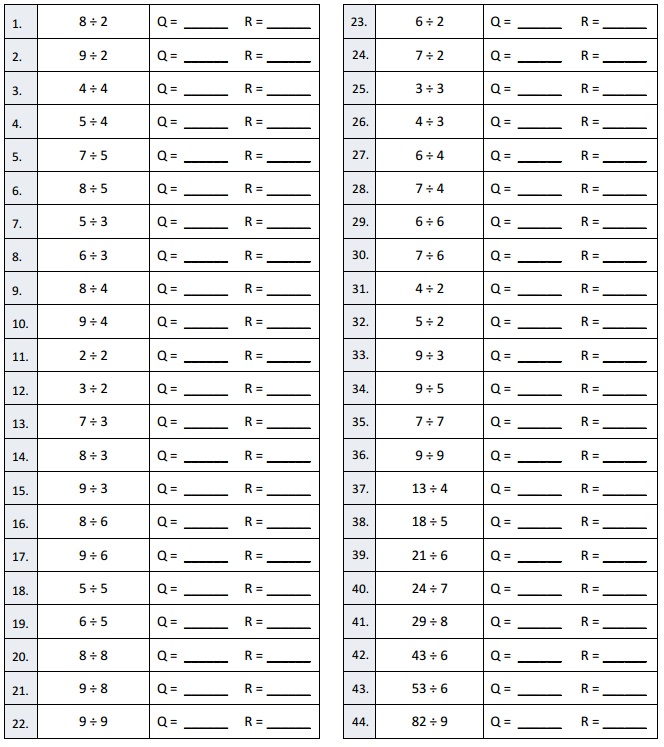
Answer:

Question 1.
8 ÷ 2 Q = ___4___ R = ___0___
Answer:
8 ÷ 2 = 4
quotient = 4 and remainder = 0,
Explanation:
Given 8 ÷ 2 when 8 is divided by 2 we get quotient as 4,
(2 X 4 = 8) and remainder is 0.
Question 2.
9 ÷ 2 Q = ___4___ R = ___1___
Answer:
9 ÷ 2 =
quotient = 4 and remainder = 1,
Explanation:
Given 9 ÷ 2 when 9 is divided by 2 we get quotient as 4,
(2 X 4 = 8) and remainder is 1.
Question 3.
4 ÷ 4 Q = __1____ R = __0____
Answer:
4 ÷ 4 =
quotient = 1 and remainder = 0,
Explanation:
Given 4 ÷ 4 when 4 is divided by 4 we get quotient as 1,
(4 X 1 = 4) and remainder is 0.
Question 4.
5 ÷ 4 Q = ___1___ R = ___1___
Answer:
5 ÷ 4 =
quotient = 1 and remainder = 1,
Explanation:
Given 5 ÷ 4 when 5 is divided by 4 we get quotient as 1,
(4 X 1 = 4) and remainder is 1.
Question 5.
7 ÷ 5 Q = __1____ R = ___2___
Answer:
7 ÷ 5 =
quotient = 1 and remainder = 2,
Explanation:
Given 7 ÷ 5 when 7 is divided by 5 we get quotient as 1,
(5 X 1 = 5) and remainder is 2.
Question 6.
8 ÷ 5 Q = ___1___ R = __3____
Answer:
8 ÷ 5 =
quotient = 1 and remainder = 3,
Explanation:
Given 8 ÷ 5 when 8 is divided by 5 we get quotient as 1,
(5 X 1 = 5) and remainder is 3.
Question 7.
5 ÷ 3 Q = ___1___ R = __2____
Answer:
5 ÷ 3 =
quotient = 1 and remainder = 2,
Explanation:
Given 5 ÷ 3 when 5 is divided by 3 we get quotient as 1,
(3 X 1 = 3) and remainder is 2.
Question 8.
6 ÷ 3 Q = __2____ R = __0__
Answer:
6 ÷ 3 =
quotient = 2 and remainder = 0,
Explanation:
Given 6 ÷ 3 when 6 is divided by 3 we get quotient as 2,
(3 X 2 = 6) and remainder is 0.
Question 9.
8 ÷ 4 Q = __2____ R = __0____
Answer:
8 ÷ 4 =
quotient = 2 and remainder = 0,
Explanation:
Given 8 ÷ 4 when 8 is divided by 4 we get quotient as 2,
(4 X 2 = 8) and remainder is 0.
Question 10.
9 ÷ 4 Q = __2____ R = ___1___
Answer:
9 ÷ 4 =
quotient = 2 and remainder = 1,
Explanation:
Given 9 ÷ 4 when 9 is divided by 4 we get quotient as 2,
(4 X 2 = 8) and remainder is 1.
Question 11.
2 ÷ 2 Q = ___1___ R = __0____
Answer:
2 ÷ 2 =
quotient = 1 and remainder = 0,
Explanation:
Given 2 ÷ 2 when 2 is divided by 2 we get quotient as 1,
(2 X 1 = 2) and remainder is 0.
Question 12.
3 ÷ 2 Q = __1____ R = __1____
Answer:
3 ÷ 2 =
quotient = 1 and remainder = 1,
Explanation:
Given 3 ÷ 2 when 3 is divided by 2 we get quotient as 1,
(2 X 1 = 2) and remainder is 1.
Question 13.
7 ÷ 3 Q = __2____ R = __1____
Answer:
7 ÷ 3 =
quotient = 2 and remainder = 1,
Explanation:
Given 7 ÷ 3 when 7 is divided by 3 we get quotient as 2,
(3 X 2 = 6) and remainder is 1.
Question 14.
8 ÷ 3 Q = ___2___ R = ___2___
Answer:
8 ÷ 3 =
quotient = 2 and remainder = 2,
Explanation:
Given 8 ÷ 3 when 8 is divided by 3 we get quotient as 2,
(3 X 2 = 6) and remainder is 2.
Question 15.
9 ÷ 3 Q = __3____ R = __0____
Answer:
9 ÷ 3 =
quotient = 3 and remainder = 0,
Explanation:
Given 9 ÷ 3 when 9 is divided by 3 we get quotient as 3,
(3 X 3 = 9) and remainder is 0.
Question 16.
8 ÷ 6 Q = ___1___ R = __2____
Answer:
8 ÷ 6 =
quotient = 1 and remainder = 2,
Explanation:
Given 8 ÷ 6 when 8 is divided by 6 we get quotient as 1,
(6 X 1 = 6) and remainder is 2.
Question 17.
9 ÷ 6 Q = __1____ R = __3____
Answer:
9 ÷ 6 =
quotient = 1 and remainder = 3,
Explanation:
Given 9 ÷ 6 when 9 is divided by 6 we get quotient as 1,
(6 X 1 = 6) and remainder is 3.
Question 18.
5 ÷ 5 Q = ___1___ R = __0____
Answer:
5÷ 5 =
quotient = 1 and remainder = 0,
Explanation:
Given 5 ÷ 5 when 5 is divided by 5 we get quotient as 1,
(5 X 1 = 5) and remainder is 0.
Question 19.
6 ÷ 5 Q = ____1__ R = __1____
Answer:
6 ÷ 5 =
quotient = 1 and remainder = 1,
Explanation:
Given 6 ÷ 5 when 6 is divided by 5 we get quotient as 1,
(5 X 1 = 5) and remainder is 1.
Question 20.
8 ÷ 8 Q = __1____ R = __0____
Answer:
8 ÷ 8 =
quotient = 1 and remainder = 0,
Explanation:
Given 8 ÷ 8 when 8 is divided by 8 we get quotient as 1,
(8 X 1 = 8) and remainder is 0.
Question 21.
9 ÷ 8 Q = ___1___ R = __1____
Answer:
9 ÷ 8 =
quotient = 1 and remainder = 1,
Explanation:
Given 9 ÷ 8 when 9 is divided by 8 we get quotient as 1,
(8 X 1 = 8) and remainder is 1.
Question 22.
9 ÷ 9 Q = ___1___ R = __0____
Answer:
9 ÷ 9 =
quotient = 1 and remainder = 0,
Explanation:
Given 9 ÷ 9 when 9 is divided by 9 we get quotient as 1,
(9 X 1 = 9) and remainder is 0.
Question 23.
6 ÷ 2 Q = ___3___ R = __0____
Answer:
6 ÷ 2 =
quotient = 3 and remainder = 0,
Explanation:
Given 6 ÷ 2 when 6 is divided by 2 we get quotient as 3,
(2 X 3 = 6) and remainder is 0.
Question 24.
7 ÷ 2 Q = __3____ R = __1____
Answer:
7 ÷ 2 =
quotient = 3 and remainder = 1,
Explanation:
Given 7 ÷ 2 when 7 is divided by 2 we get quotient as 3,
(2 X 3 = 6) and remainder is 1.
Question 25.
3 ÷ 3 Q = __1____ R = __0____
Answer:
3 ÷ 3 =
quotient = 1 and remainder = 0,
Explanation:
Given 3 ÷ 3 when 3 is divided by 3 we get quotient as 1,
(3 X 1 = 3) and remainder is 0.
Question 26.
4 ÷ 3 Q = ___1___ R = __1____
Answer:
4 ÷ 3 =
quotient = 1 and remainder = 1,
Explanation:
Given 4 ÷ 3 when 4 is divided by 3 we get quotient as 1,
(3 X 1 = 3) and remainder is 1.
Question 27.
6 ÷ 4 Q = ___1___ R = ___2___
Answer:
6 ÷ 4 =
quotient = 1 and remainder = 2,
Explanation:
Given 6 ÷ 4 when 6 is divided by 4 we get quotient as 1,
(4 X 1 = 4) and remainder is 2.
Question 28.
7 ÷ 4 Q = __1____ R = __3____
Answer:
7 ÷ 4 =
quotient = 1 and remainder = 3,
Explanation:
Given 7 ÷ 4 when 7 is divided by 4 we get quotient as 1,
(4 X 1 = 4) and remainder is 3.
Question 29.
6 ÷ 6 Q = ___1___ R = __0____
Answer:
6 ÷ 6 =
quotient = 1 and remainder = 0,
Explanation:
Given 6 ÷ 6 when 6 is divided by 6 we get quotient as 1,
(6 X 1 = 6) and remainder is 0.
Question 30.
7 ÷ 6 Q = ___1___ R = __1____
Answer:
7 ÷ 6 =
quotient = 1 and remainder = 1,
Explanation:
Given 7 ÷ 6 when 7 is divided by 6 we get quotient as 1,
(6 X 1 = 6) and remainder is 1.
Question 31.
4 ÷ 2 Q = ___2___ R = ___0___
Answer:
4 ÷ 2 =
quotient = 2 and remainder = 0,
Explanation:
Given 4 ÷ 2 when 4 is divided by 2 we get quotient as 2,
(2 X 2 = 4) and remainder is 0.
Question 32.
5 ÷ 2 Q = __2____ R = __1____
Answer:
5 ÷ 2 =
quotient = 2 and remainder = 1,
Explanation:
Given 5 ÷ 2 when 5 is divided by 2 we get quotient as 2,
(2 X 2 = 4) and remainder is 1.
Question 33.
9 ÷ 3 Q = ___3___ R = __0____
Answer:
9 ÷ 3 =
quotient = 3 and remainder = 0,
Explanation:
Given 9 ÷ 3 when 9 is divided by 3 we get quotient as 3,
(3 X 3= 9) and remainder is 0.
Question 34.
9 ÷ 5 Q = ___1___ R = ___4___
Answer:
9 ÷ 5 =
quotient = 1 and remainder = 4,
Explanation:
Given 9 ÷ 5 when 9 is divided by 5 we get quotient as 1,
(5 X 1 = 5) and remainder is 4.
Question 35.
7 ÷ 7 Q = __1____ R = __0____
Answer:
7 ÷ 7 =
quotient = 1 and remainder = 0,
Explanation:
Given 7 ÷ 7 when 7 is divided by 7 we get quotient as 1,
(7 X 1 = 7) and remainder is 0.
Question 36.
9 ÷ 9 Q = ___1___ R = __0____
Answer:
9 ÷ 9 =
quotient = 1 and remainder = 0,
Explanation:
Given 9 ÷ 9 when 9 is divided by 9 we get quotient as 1,
(9 X 1 = 9) and remainder is 0.
Question 37.
13 ÷ 4 Q = ___3___ R = __1____
Answer:
13 ÷ 4 =
quotient = 3 and remainder = 1,
Explanation:
Given 13 ÷ 4 when 13 is divided by 4 we get quotient as 3,
(4 X 3 = 12) and remainder is 1.
Question 38.
18 ÷ 5 Q = ___3___ R = __3____
Answer:
18 ÷ 5 =
quotient = 3 and remainder = 3,
Explanation:
Given 18 ÷ 5 when 18 is divided by 5 we get quotient as 3,
(5 X 3 = 15) and remainder is 3.
Question 39.
21 ÷ 6 Q = ____3__ R = __3____
Answer:
21 ÷ 6 =
quotient = 3 and remainder = 3,
Explanation:
Given 21 ÷ 6 when 21 is divided by 6 we get quotient as 3,
(6 X 3 = 18) and remainder is 3.
Question 40.
24 ÷ 7 Q = __3____ R = __3____
Answer:
24 ÷ 7 =
quotient = 3 and remainder = 3,
Explanation:
Given 24 ÷ 7 when 24 is divided by 7 we get quotient as 3,
(7 X 3 = 21) and remainder is 3.
Question 41.
29 ÷ 8 Q = __3____ R = __5____
Answer:
29 ÷ 8 =
quotient = 3 and remainder = 5,
Explanation:
Given 29 ÷ 8 when 29 is divided by 8 we get quotient as 3,
(8 X 3 = 24) and remainder is 5.
Question 42.
43 ÷ 6 Q = ___7___ R = __1____
Answer:
43 ÷ 6 =
quotient = 7 and remainder = 1,
Explanation:
Given 43 ÷ 6 when 43 is divided by 6 we get quotient as 7,
(6 X 7 = 42) and remainder is 1.
Question 43.
53 ÷ 6 Q = __8____ R = ___5___
Answer:
53 ÷ 6 =
quotient = 8 and remainder = 5,
Explanation:
Given 53 ÷ 6 when 53 is divided by 6 we get quotient as 8,
(6 X 8 = 48) and remainder is 5.
Question 44.
82 ÷ 9 Q = ___9___ R = ___1___
Answer:
82 ÷ 9 =
quotient = 9 and remainder = 1,
Explanation:
Given 82 ÷ 9 when 82 is divided by 9 we get quotient as 9,
(9 X 9 = 81) and remainder is 1.
Division with Remainders
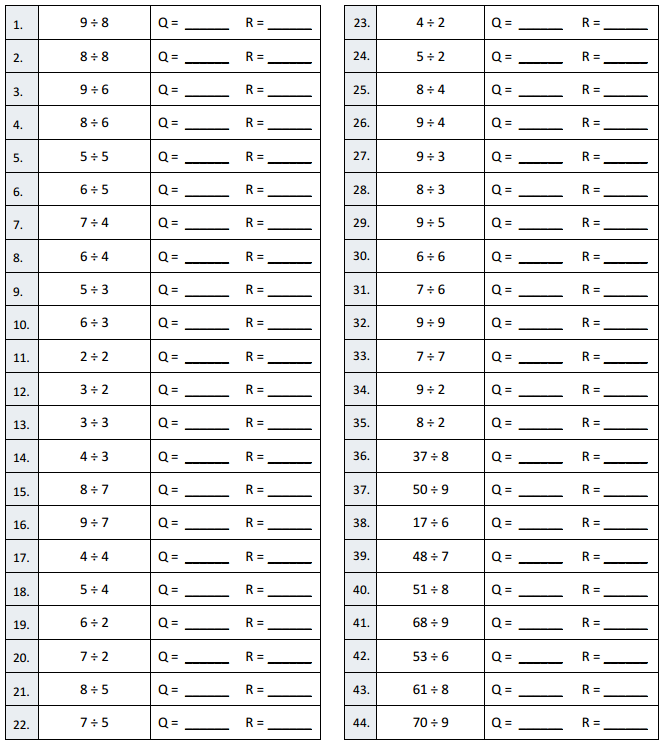
Answer:

Question 1.
9 ÷ 8 Q = __1____ R = __1____
Answer:
9 ÷ 8 =
quotient = 1 and remainder = 1,
Explanation:
Given 9 ÷ 8 when 9 is divided by 8 we get quotient as 1,
(8 X 1 = 8) and remainder is 1.
Question 2.
8 ÷ 8 Q = __1____ R = ___0___
Answer:
8 ÷ 8 =
quotient = 1 and remainder = 0,
Explanation:
Given 9 ÷ 8 when 9 is divided by 8 we get quotient as 1,
(8 X 1 = 8) and remainder is 1.
Question 3.
9 ÷ 6 Q = __1____ R = ___2___
Answer:
9 ÷ 6 =
quotient = 1 and remainder = 2,
Explanation:
Given 9 ÷ 6 when 9 is divided by 6 we get quotient as 1,
(6 X 1 = 6) and remainder is 2.
Question 4.
8 ÷ 6 Q = __1____ R = __2____
Answer:
8 ÷ 6 =
quotient = 1 and remainder = 2,
Explanation:
Given 8 ÷ 6 when 8 is divided by 6 we get quotient as 1,
(6 X 1 = 6) and remainder is 2.
Question 5.
5 ÷ 5 Q = __1____ R = __0____
Answer:
5 ÷ 5 =
quotient = 1 and remainder = 0,
Explanation:
Given 5 ÷ 5 when 5 is divided by 5 we get quotient as 1,
(5 X 1 = 5) and remainder is 0.
Question 6.
6 ÷ 5 Q = ___1___ R = __1____
Answer:
6 ÷ 5 =
quotient = 1 and remainder = 1,
Explanation:
Given 6 ÷ 5 when 6 is divided by 5 we get quotient as 1,
(5 X 1 = 5) and remainder is 1.
Question 7.
7 ÷ 4 Q = ___1___ R = __3____
Answer:
7 ÷ 4 =
quotient = 1 and remainder = 3,
Explanation:
Given 7 ÷ 4 when 7 is divided by 4 we get quotient as 3,
(4 X 1 = 4) and remainder is 3.
Question 8.
6 ÷ 4 Q = __1____ R = __2____
Answer:
6 ÷ 4 =
quotient = 1 and remainder = 2,
Explanation:
Given 6 ÷ 4 when 6 is divided by 4 we get quotient as 1,
(4 X 1 = 4) and remainder is 2.
Question 9.
5 ÷ 3 Q = __1____ R = __2____
Answer:
5 ÷ 3 =
quotient = 1 and remainder = 2,
Explanation:
Given 5 ÷ 3 when 5 is divided by 3 we get quotient as 1,
(3 X 1 = 3) and remainder is 2.
Question 10.
6 ÷ 3 Q = __2____ R = ___0___
Answer:
6 ÷ 3 =
quotient = 2 and remainder = 0,
Explanation:
Given 6 ÷ 3 when 6 is divided by 3 we get quotient as 2,
(3 X 2 = 6) and remainder is 0.
Question 11.
2 ÷ 2 Q = __1____ R = __0____
Answer:
2 ÷ 2 =
quotient = 1 and remainder = 0,
Explanation:
Given 2 ÷ 2 when 2 is divided by 2 we get quotient as 1,
(2 X 1 = 2) and remainder is 0.
Question 12.
3 ÷ 2 Q = ___1___ R = ___1___
Answer:
3 ÷ 2 =
quotient = 1 and remainder = 1,
Explanation:
Given 3 ÷ 2 when 3 is divided by 2 we get quotient as 1,
(2 X 1 = 2) and remainder is 1.
Question 13.
3 ÷ 3 Q = ___1___ R = __0____
Answer:
3 ÷ 3 =
quotient = 1 and remainder = 0,
Explanation:
Given 3 ÷ 3 when 3 is divided by 3 we get quotient as 1,
(3 X 1 = 3) and remainder is 0.
Question 14.
4 ÷ 3 Q = __1___ R = ___1___
Answer:
4 ÷ 3 =
quotient = 1 and remainder = 1,
Explanation:
Given 4 ÷ 3 when 4 is divided by 3 we get quotient as 1,
(3 X 1 = 3) and remainder is 1.
Question 15.
8 ÷ 7 Q = __1____ R = ___1__
Answer:
8 ÷ 7 =
quotient = 1 and remainder = 1,
Explanation:
Given 8 ÷ 7 when 8 is divided by 7 we get quotient as 1,
(7 X 1 = 7) and remainder is 1.
Question 16.
9 ÷ 7 Q = ___1___ R = __2____
Answer:
Question 17.
4 ÷ 4 Q = ___1___ R = ___0___
Answer:
4 ÷ 4 =
quotient = 1 and remainder = 0,
Explanation:
Given 4 ÷ 4 when 4 is divided by 4 we get quotient as 1,
(4 X 1 = 4) and remainder is 0.
Question 18.
5 ÷ 4 Q = ___1___ R = __1____
Answer:
5 ÷ 4 =
quotient = 1 and remainder = 1,
Explanation:
Given 5 ÷ 4 when 5 is divided by 4 we get quotient as 1,
(4 X 1 = 4) and remainder is 1.
Question 19.
6 ÷ 2 Q = __3____ R = __0____
Answer:
6 ÷ 2 =
quotient = 3 and remainder = 0,
Explanation:
Given 6÷ 2 when 6 is divided by 2 we get quotient as 3,
(3 X 1 = 3) and remainder is 0.
Question 20.
7 ÷ 2 Q = __3____ R = __1____
Answer:
7 ÷ 2 =
quotient = 3 and remainder = 1,
Explanation:
Given 7 ÷ 2 when 7 is divided by 2 we get quotient as 3,
(2 X 3 = 6) and remainder is 1.
Question 21.
8 ÷ 5 Q = __1____ R = __3____
Answer:
8 ÷ 5 =
quotient = 1 and remainder = 3,
Explanation:
Given 8 ÷ 5 when 8 is divided by 5 we get quotient as 1,
(5 X 1 = 5) and remainder is 3.
Question 22.
7 ÷ 5 Q = ___1___ R = __2____
Answer:
7 ÷ 5 =
quotient = 1 and remainder = 2,
Explanation:
Given 7 ÷ 5 when 7 is divided by 5 we get quotient as 1,
(5 X 1 = 5) and remainder is 2.
Question 23.
4 ÷ 2 Q = __2____ R = __0____
Answer:
4 ÷ 2 =
quotient = 2 and remainder = 0,
Explanation:
Given 4 ÷ 2 when 4 is divided by 2 we get quotient as 2,
(2 X 1 = 2) and remainder is 0.
Question 24.
5 ÷ 2 Q = __2____ R = __1____
Answer:
5 ÷ 2 =
quotient = 2 and remainder = 1,
Explanation:
Given 5 ÷ 2 when 5 is divided by 2 we get quotient as 2,
(2 X 2 = 4) and remainder is 1.
Question 25.
8 ÷ 4 Q = ___2___ R = ___0___
Answer:
8 ÷ 4 =
quotient = 2 and remainder = 0,
Explanation:
Given 8 ÷ 4 when 8 is divided by 4 we get quotient as 2,
(4 X 2 = 8) and remainder is 0.
Question 26.
9 ÷ 4 Q = ___2___ R = __1____
Answer:
9 ÷ 4 =
quotient = 2 and remainder = 1,
Explanation:
Given 9 ÷ 4 when 9 is divided by 4 we get quotient as 2,
(4 X 2 = 8) and remainder is 1.
Question 27.
9 ÷ 3 Q = ___3___ R = __0____
Answer:
9 ÷ 3 =
quotient = 3 and remainder = 0,
Explanation:
Given 9 ÷ 3 when 9 is divided by 3 we get quotient as 3,
(3 X 3 = 9) and remainder is 0.
Question 28.
8 ÷ 3 Q = ___2___ R = __2____
Answer:
8 ÷ 3 =
quotient = 2 and remainder = 2,
Explanation:
Given 8 ÷ 3 when 8 is divided by 3 we get quotient as 2,
(3 X 2 = 6) and remainder is 2.
Question 29.
9 ÷ 5 Q = __1____ R = ___4___
Answer:
9 ÷ 5 =
quotient = 1 and remainder = 4,
Explanation:
Given 9 ÷ 5 when 9 is divided by 5 we get quotient as 1,
(5 X 1 = 5) and remainder is 4.
Question 30.
6 ÷ 6 Q = ___1___ R = ___0___
Answer:
6 ÷ 6 =
quotient = 1 and remainder = 0,
Explanation:
Given 6 ÷ 6 when 6 is divided by 6 we get quotient as 1,
(6 X 1 = 6) and remainder is 0.
Question 31.
7 ÷ 6 Q = __1____ R = ___1___
Answer:
7 ÷ 6 =
quotient = 1 and remainder = 1,
Explanation:
Given 7 ÷ 6 when 7 is divided by 6 we get quotient as 1,
(6 X 1 = 6) and remainder is 1.
Question 32.
9 ÷ 9 Q = __1____ R = ___0___
Answer:
9 ÷ 9 =
quotient = 1 and remainder = 0,
Explanation:
Given 9 ÷ 9 when 9 is divided by 9 we get quotient as 1,
(9 X 1 = 9) and remainder is 0.
Question 33.
7 ÷ 7 Q = ___1___ R = _0_____
Answer:
7 ÷ 7 =
quotient = 1 and remainder = 0,
Explanation:
Given 7 ÷ 7 when 7 is divided by 7 we get quotient as 1,
(7 X 1 = 7) and remainder is 0.
Question 34.
9 ÷ 2 Q = ___4___ R = ___1___
Answer:
9 ÷ 2 =
quotient = 4 and remainder = 1,
Explanation:
Given 9 ÷ 2 when 9 is divided by 2 we get quotient as 4,
(2 X 4 = 8) and remainder is 1.
Question 35.
8 ÷ 2 Q = ___4___ R = ___0___
Answer:
8 ÷ 2 =
quotient = 4 and remainder = 0,
Explanation:
Given 8 ÷ 2 when 8 is divided by 2 we get quotient as 4,
(2 X 4 = 8) and remainder is 0.
Question 36.
37 ÷ 8 Q = ___4___ R = ___5___
Answer:
37 ÷ 8 =
quotient = 4 and remainder = 5,
Explanation:
Given 37 ÷ 8 when 37 is divided by 8 we get quotient as 4,
(8 X 4 = 32) and remainder is 5.
Question 37.
50 ÷ 9 Q = ___5___ R = __5____
Answer:
50 ÷ 9 =
quotient = 5 and remainder = 5,
Explanation:
Given 50 ÷ 9 when 50 is divided by 9 we get quotient as 5,
(9 X 5 = 45) and remainder is 5.
Question 38.
17 ÷ 6 Q = ___2___ R = __5____
Answer:
17 ÷ 6 =
quotient = 2 and remainder = 5,
Explanation:
Given 17 ÷ 6 when 17 is divided by 6 we get quotient as 2,
(6 X 2 = 12) and remainder is 5.
Question 39.
48 ÷ 7 Q = __6____ R = __6____
Answer:
48 ÷ 7 =
quotient = 6 and remainder = 6,
Explanation:
Given 48 ÷ 7 when 48 is divided by 7 we get quotient as 6,
(7 X 6 = 42) and remainder is 6.
Question 40.
51 ÷ 8 Q = ___6___ R = ___3___
Answer:
51 ÷ 8 =
quotient = 6 and remainder = 3,
Explanation:
Given 51 ÷ 8 when 51 is divided by 8 we get quotient as 6,
(8 X 6 = 48) and remainder is 3.
Question 41.
68 ÷ 9 Q = __7____ R = ___5___
Answer:
68 ÷ 9 =
quotient = 7 and remainder = 5,
Explanation:
Given 68 ÷ 9 when 68 is divided by 9 we get quotient as 7,
(9 X 7= 63) and remainder is 5.
Question 42.
53 ÷ 6 Q = __8____ R = __5____
Answer:
53 ÷ 6 =
quotient = 8 and remainder = 5,
Explanation:
Given 53 ÷ 6 when 53 is divided by 6 we get quotient as 8,
(6 X 8 = 48) and remainder is 5.
Question 43.
61 ÷ 8 Q = ___7___ R = __5____
Answer:
61 ÷ 8 =
quotient = 7 and remainder = 5,
Explanation:
Given 61 ÷ 8 when 61 is divided by 8 we get quotient as 71,
(8 X 7 = 56) and remainder is 5.
Question 44.
70 ÷ 9 Q = __7____ R = __7____
Answer:
70 ÷ 9 =
quotient = 7 and remainder = 7,
Explanation:
Given 70 ÷ 9 when 70 is divided by 9 we get quotient as 7,
(9 X 7 = 63) and remainder is 7.
Eureka Math Grade 4 Module 3 Lesson 21 Problem Set Answer Key
Question 1.
Solve 37 ÷ 2 using an area model. Use long division and
the distributive property to record your work.
Answer:
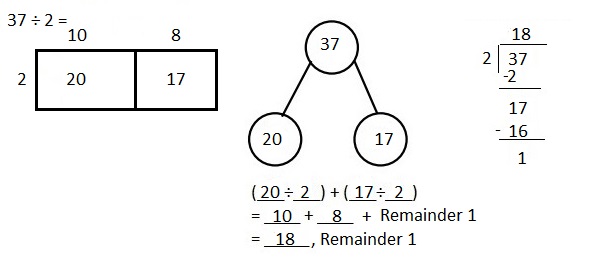
Explanation:
Solved 37 ÷ 2 using an area model. Using long division and the distributive property to record my work as shown above.
Question 2.
Solve 76 ÷ 3 using an area model. Use long division and the distributive property to record your work.
Answer:

Explanation:
Solved 76 ÷ 3 using an area model. Used long division and the distributive property to record your work.
Question 3.
Carolina solved the following division problem by drawing an area model.

a. What division problem did she solve?
Answer:
53 ÷ 4
Explanation:
Carolina solved the following division problem by using an area model as 40 + 12 + 1 = 53 divided by 4.
b. Show how Carolina’s model can be represented using the distributive property.
Answer:
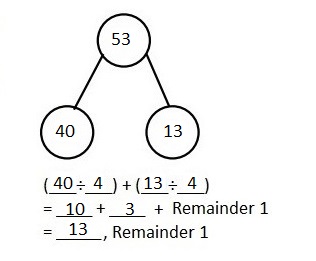
Explanation:
Shown how Carolina’s model can be represented using the distributive property above.
Solved the following problems using the area model. Supported the area model with long division or the distributive property.
Question 4.
48 ÷ 3
Answer:
48 ÷ 3 =
quotient = 16 and remainder = 0,
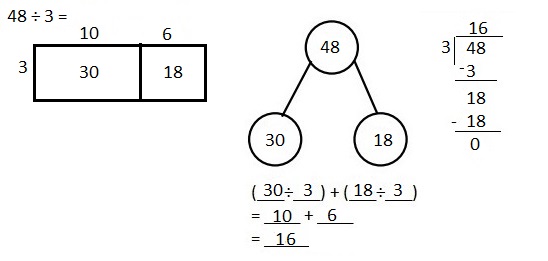
Explanation:
Given 48 ÷ 3 when 48 is divided by 3 we get quotient as 16,
(3 X 16 = 48) and remainder is 0.
Solved the following problem using the area model. Supported the area model with long division and the distributive property.
Question 5.
49 ÷ 3
Answer:
49 ÷ 3 =
quotient = 16 and remainder = 1,
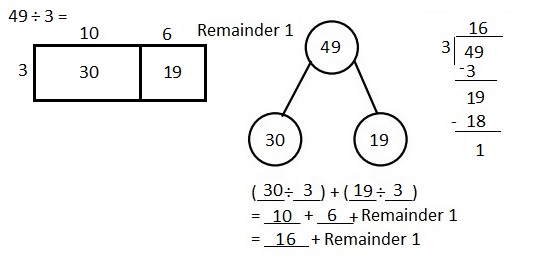
Explanation:
Given 49 ÷ 3 when 49 is divided by 3 we get quotient as 16,
(3 X 16 = 48) and remainder is 1.
Solved the following problem using the area model. Supported the area model with long division and the distributive property.
Question 6.
56 ÷ 4
Answer:
56 ÷ 4 =
quotient = 14 and remainder = 0,
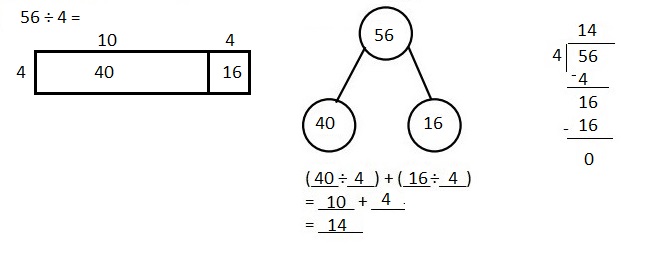
Explanation:
Given 56 ÷ 4 when 56 is divided by 4 we get quotient as 14, (4 X 14 = 56) and remainder is 0.
Solved the following problem using the area model. Supported the area model with long division and the distributive property.
Question 7.
58 ÷ 4
Answer:
58 ÷ 4 =
quotient = 14 and remainder = 2,
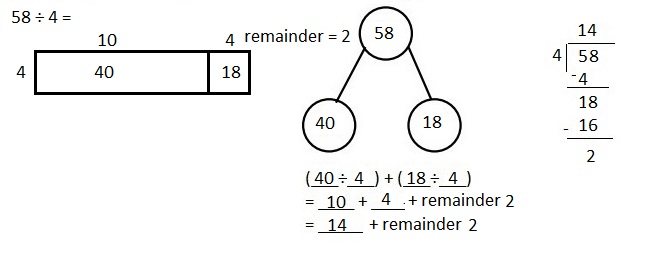
Explanation:
Given 58 ÷ 4 when 58 is divided by 4 we get quotient as 14, (4 X 14 = 58) and remainder is 2.
Solved the following problem using the area model. Supported the area model with long division and the distributive property.
Question 8.
66 ÷ 5
Answer:
66 ÷ 5 =
quotient = 13 and remainder = 1,
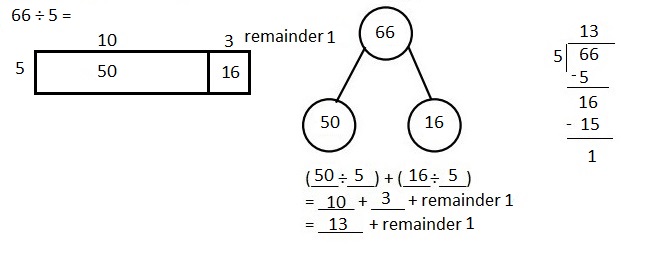
Explanation:
Given 66 ÷ 5 when 66 is divided by 5 we get quotient as 13, (5 X 13 = 65) and remainder is 1.
Solved the following problem using the area model. Supported the area model with long division and the distributive property.
Question 9.
79 ÷ 3
Answer:
79 ÷ 3 =
quotient = 26 and remainder = 1,

Explanation:
Given 79 ÷ 3 when 79 is divided by 3 we get quotient as 26,
(3 X 26 = 78 ) and remainder is 1.
Solved the following problem using the area model. Supported the area model with long division and the distributive property.
Question 10.
Seventy-three students are divided into groups of 6 students each. How many groups of 6 students are there? How many students will not be in a group of 6?
Answer:
There are 12 groups of 6 students are there, 1 student will not be in a group of 6,
Explanation:
Given Seventy-three students are divided into groups of 6 students each.
The number of groups of 6 students are 73 ÷ 6 = quotient = 12 and remainder = 1 means there are 12 groups of 6 students are there and 1 student will not be in a group of 6.
Eureka Math Grade 4 Module 3 Lesson 21 Exit Ticket Answer Key
Question 1.
Kyle drew the following area model to find an unknown length. What division equation did he model?
![]()
Answer:
Kyle’s equation is 59 ÷ 2,
Explanation:
Kyle drew the following area model to find an unknown length.
The division equation did he modeled is 59 ÷ 2 as
(40 + 18 + 1) ÷ 2 = 59 ÷ 2.
Question 2.
Solve 93 ÷ 4 using the area model, long division, and the distributive property.
Answer:

Explanation:
Solved 93 ÷ 4 using the area model, long division, and the distributive property as shown above.
Eureka Math Grade 4 Module 3 Lesson 22 Homework Answer Key
Question 1.
Solve 35 ÷ 2 using an area model. Use long division and the distributive property to record your work.
Answer:
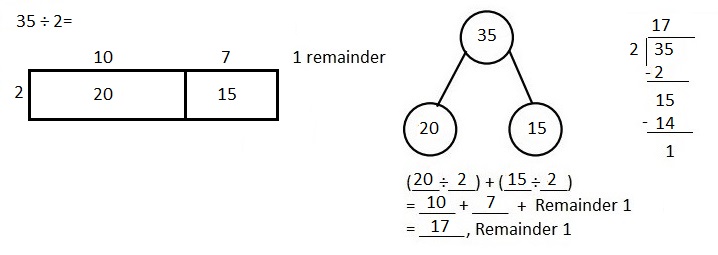
Explanation:
Solved 35 ÷ 2 using an area model. Used long division and the distributive property to record my work as shown above.
Question 2.
Solve 79 ÷ 3 using an area model. Use long division and the distributive property to record your work.
Answer:

Explanation:
Solved 79 ÷ 3 using an area model. Used long division and the distributive property to record your work.
Question 3.
Paulina solved the following division problem by drawing an
area model.

a. What division problem did she solve?
Answer:
Paulina solved the following division problem as 98 ÷ 4,
Explanation:
Paulina solved the following division problem by drawing an area model as (40 + 40 + 16 + 2) ÷ 4 = 98 ÷ 4.
b. Show how Paulina’s model can be represented using the
distributive property.
Answer:
 Explanation:
Explanation:
Shown how Paulina’s model can be represented using the distributive property above.
Solve the following problems using the area model. Support the area model with long division or the distributive property.
Question 4.
42 ÷ 3
Answer:
42 ÷ 3 =
quotient = 14 and remainder = 0,

Explanation:
Given 42 ÷ 3 when 14 is divided by 3 we get quotient as 14,
(3 X 14 = 42) and remainder is 0.
Solved the following problem using the area model. Supported the area model with long division and the distributive property.
Question 5.
43 ÷ 3
Answer:
43 ÷ 3 =
quotient = 14 and remainder = 1,
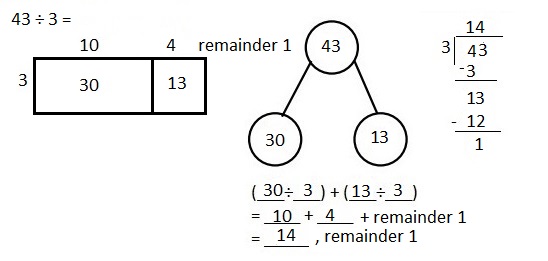
Explanation:
Given 43 ÷ 3 when 43 is divided by 3 we get quotient as 14,
(3 X 14 = 42) and remainder is 1.
Solved the following problem using the area model. Supported the area model with long division and the distributive property.
Question 6.
52 ÷ 4
Answer:
52 ÷ 4 =
quotient = 13 and remainder = 0,
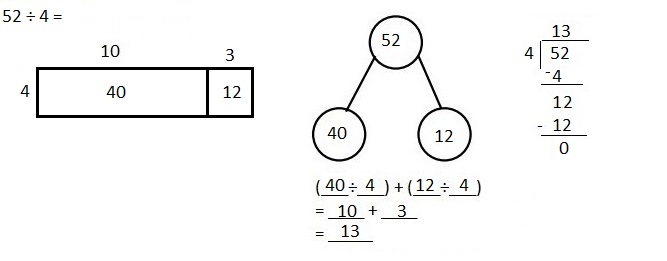
Explanation:
Given 52 ÷ 4 when 52 is divided by 4 we get quotient as 13,
(4 X 13 = 52) and remainder is 0.
Solved the following problem using the area model. Supported the area model with long division and the distributive property.
Question 7.
54 ÷ 4
Answer:
54 ÷ 4 =
quotient = 13 and remainder = 2,
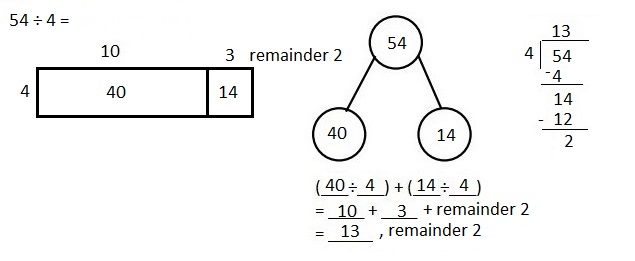 Explanation:
Explanation:
Given 54 ÷ 4 when 54 is divided by 4 we get quotient as 13,
(4 X 13 = 52) and remainder is 2.
Solved the following problem using the area model. Supported the area model with long division and the distributive property.
Question 8.
61 ÷ 5
Answer:
61 ÷ 5 =
quotient = 12 and remainder = 1,
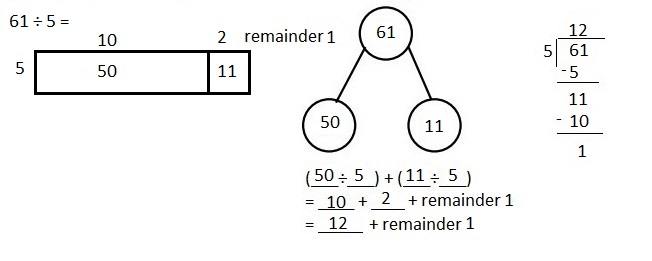
Explanation:
Given 61 ÷ 5 when 61 is divided by 5 we get quotient as 12,
(5 X 12 = 60) and remainder is 1.
Solved the following problem using the area model. Supported the area model with long division and the distributive property.
Question 9.
73 ÷ 3
Answer:
73 ÷ 3 =
quotient = 24 and remainder = 1,

Explanation:
Given 73 ÷ 3 when 73 is divided by 3 we get quotient as 24,
(3 X 24 = 73) and remainder is 1.
Solved the following problem using the area model. Supported the area model with long division and the distributive property.